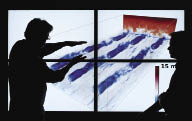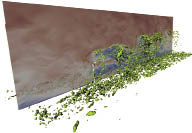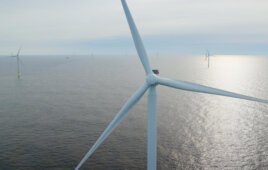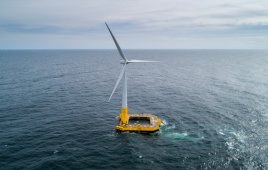
NREL’s Steve Hammond, Director of Computational Science Center and Senior Scientist Kenny Gruchalla discuss a 3D model of wind-plant aerodynamics, showing low velocity wakes and impact on downstream turbines. Photo: Dennis Schroeder
A supercomputer that quickly runs complex airflow models promises to provide insight into harnessing energy from the wind, sun, and other renewable sources.
Red Mesa, a 180-teraflop computer (180 trillion floating-point operations/sec) is operating at Sandia National Laboratories in a collaboration between Sandia and the National Renewable Energy Laboratory (NREL). The two labs dedicated the supercomputer late in 2011. The computer now brings defense-scale computing to bear on alternative energy projects that otherwise could take months to complete if researchers had to rely on more limited computing resources or physical testing.
Another computer, RedSky, at the Sandia National Laboratories, has proved so useful that NREL scientists have kept the system running at capacity—day and night—for the past year. The computer is being used to explore ideas regarding biomass, solar, and wind-energy technologies.
One program, for instance, simulates the behavior of individual wind turbines along with multi-turbine configurations in complex environments, such as high winds and extreme turbulence—even hurricanes. Advanced software will model the effects of turbulent inflow, including unsteady aerodynamic forces, and inflow effects on structural dynamics and drive-train response. Hence, well before building the first U.S. offshore wind project, high-performance computer (HPC) models can test hydrodynamic loading to help ensure builders deploy the best possible designs.

Large-eddy simulation is of a neutrally stable atmospheric boundary layer with wind-turbine blade aerodynamics modeled using actuator lines. A vertical cross-section shows streamwise velocity magnitude (high velocities in red, low velocities in blue). A low-velocity wake develops behind the turbine. The green isosurfaces are q-criterion (second invariant of the velocity gradient), showing the vortical (vortex) structures trailing from the blade. Photo: Matthew Churchfield and Kenny Gruchalla/NREL
To improve simulation models, results must be compared with actual observations. So in early 2011, NREL, the University of Colorado at Boulder, the National Oceanic and Atmospheric Administration, and DOE’s Lawrence Livermore National Laboratory, set up high-resolution atmospheric instrumentation to study atmospheric flow fields surrounding large wind turbines (WPE&D July 2011). The team collected meteorological data to validate turbine-wake models in a range of atmospheric conditions. Understanding and predicting wind plant aerodynamics and the impact of turbulence from upwind turbines on those downwind is vital when optimizing wind-plant turbine layouts as well as designing turbines with longer lifespans.
NREL says insights from the simulations can enhance wind-farm efficiency, help extend the life of wind turbines, and thereby reduce the cost of electricity generated from wind energy. When NREL’s computer facility completes in late 2012, it plans to acquire a new HPC with more than double Red Mesa’s computational capability. WPE
Filed Under: Offshore wind, Software




